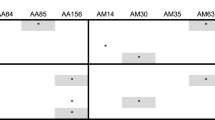Summary
Results on 167 f1 ‘mucromphs’ reported earlier were re-examined with the view of determining the potential of component characters in correct identification of parental gca status and F1 heterosis. It was found that a judicious combination of ‘plant’ and ‘ratio’ characters would be of direct usefulness in assessing population performance. The role of seedling characters in the process of making a desired level of multiple cross was illustrated. It was found that H X L mucromphs could provide a broad genetic base which has a higher probability of getting channelised into productive populations. It was concluded that ‘multiple cross-multiple pollen hybrids’ can provide a feasible solution for breeding productive composite populations in Brassica campestris.
Similar content being viewed by others
Literature
Alessandroni, A.; Scalfati, M.C. (1973): Early generation selection for grain yield of dwarf and semi-dwarf progenies of durum wheat crosses. In: Proc. 4th Intern. Wheat Genet. Symp. (eds. Sears, E.R.; Sears, L.M.S.), pp. 475–482. Missouri: Agricultural Exp. Station, Univ. of Missouri
Arunachalam, V.; Bandyopadhyay, A. (1979): Are “Multiple cross-multiple pollen hybrids” an answer for productive populations in Brassica campestris var. ‘brown sarson’? 1. Methods for studying ‘Mucromphs’. Theor. Appl. Genet. 54, 203–207
Arunachalam, V.; Srivastava, P.S.L. (1980): Assessment of genetic potential of multiple crosses in triticale. Genet. Agr. 35, 117–127
Arunachalam, V.; Reddy, B.B. (1979): Basic studies on triallel crosses in pearl millet (Pennisetum typhoides S. & H.). Z. Pflanzenzücht. 83, 368–374
Arunachalam, V.; Reddy, B.B. (1981): Evaluation of heterosis through combining ability in pearl millet. II. Multiple crosses. Indian J. Genet. 41, 73–81
Bandyopadhyay, A.; Arunachalam, V. (1980): Are “Multiple cross-multiple pollen hybrids” an answer for productive populations in Brassica campestris var. ‘brown sarson’? Part 2. Evaluation of ‘Mucromphs’. Theor. Appl. Genet. 58, 5–10
Das, G.R. (1979): Short-term strategies of population breeding from multiple crosses in rapeseed (Brassica campestris L.). Ph.D. Thesis, P.G. School, I A R I, New Delhi
Maunder, A.B. (1972): Objectives and approaches to grain and forage Sorghum improvement in the Americas. Sorghum in Seventies, (eds. Rao, N.G.P.; House, L.R.) pp. 101–142. New Delhi, Bombay, Calcutta: Oxford & I B H.
McDaniel, R.G. (1970): Mitochondrial heterosis in barley. Proc. 2nd Int. Barley Genet. Symp. pp. 323–337
McDaniel, R.G.; Sarkissian, I.V. (1966): Heterosis: complementation by mitochondria. Science 152, 1640–1642
Parker, R.C.; Wynne, J.C.; Emery, D.A. (1970): Combining ability estimates in Arachis hypogaea L. I. Seedling response in a controlled environment. Crop Sci. 10, 429–432
Rao, N.G.P.; Venkateswarlu, J. (1971): Genetic analysis of some exotic x Indian crosses in Sorghum III. Heterosis in relation to dry matter production and nutrient uptake. Indian J. Genet. 31, 156–176
Reddy, B. Balarami. (1975): Heterotic response of single and multiple crosses for direct and physiological components of yield in pearl millet. Ph. D. Thesis, P.G. School, IARI, New Delhi
Sage, G.C.M. (1973): Mitochondrial efficiency in breeding hybrid and pure-line wheat. In: Proc. 4th Int. Wheat Genet. Symp. (eds. Sears. E.R.; Sears, L.M.S.), pp. 233–236. Missouri: Agricultural Exp. Station, Univ. of Missouri
Sarkissian, I.V.; Srivastava, H. (1967): Mitochondrial polymorphism in maize. II. Further evidence of correlation of mitochondrial complementation and heterosis. Genetics 57, 843–850
Sarkissian, I.V.; Srivastava, H. (1969): High efficiency heterosis and homoeostasis in mitochondria of wheat. Proc. Nat. Acad. Sci. (USA) 63, 302–309
Worby, S, Jr.; Ramey, H.H. Jr.; Harell, D.C.; Culp, T.W. (1976): Ontogenetic model of cotton yield. Crop Sci. 16, 30–34
Wynne, J.C.; Emery, D.A. (1974): Response of interspecific peanut hybrids to photoperiod. Crop Sci. 14, 878–880
Author information
Authors and Affiliations
Additional information
Communicated by B. R. Murty
Rights and permissions
About this article
Cite this article
Bandyopadhyay, A., Arunachalam, V. Are “multiple Cross-multiple pollen hybrids” an answer for productive populations in Brassica campestris var. ‘brown sarson’?. Theoret. Appl. Genetics 61, 53–58 (1982). https://doi.org/10.1007/BF00261510
Received:
Issue Date:
DOI: https://doi.org/10.1007/BF00261510




